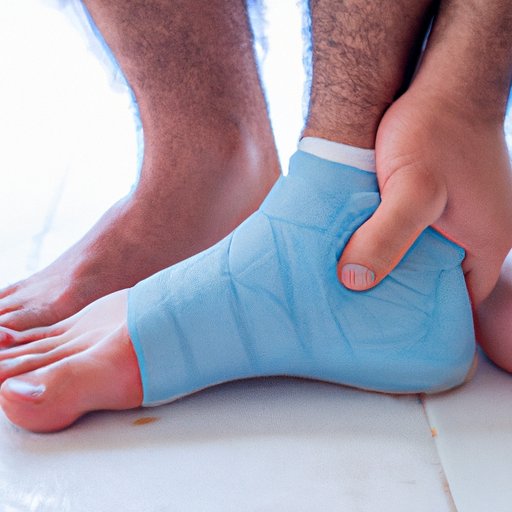Introduction
Traveling is an exciting and rewarding experience that can take us to new places, introduce us to different cultures, and give us memories to last a lifetime. But for some travelers, it can also result in swollen ankles, a condition known as travel-related ankle swelling.
In this article, we’ll explore what causes ankles to swell when traveling, and how to prevent and treat the condition. We’ll also discuss ways to reduce the risk of swelling and how to keep your ankles healthy while on the go.
Exploring the Causes of Travel-Related Ankle Swelling
Travel-related ankle swelling is caused by a variety of factors, including sitting in a confined space for extended periods, air pressure changes during flights, low humidity levels in airplanes, and poor circulation.
Sitting in a Confined Space for Extended Periods
When you’re stuck in a cramped seat for hours at a time, your feet and legs are forced into an unnatural position. This can lead to swelling in your ankles as the blood pools in your lower extremities.
Air Pressure Changes During Flights
The air pressure inside airplanes is much lower than at sea level. This can cause fluid to accumulate in your ankles, resulting in swelling.
Low Humidity Levels in Airplanes
Airplanes are typically quite dry, making it difficult for your body to absorb moisture. As a result, your skin may become dehydrated and your ankles may swell.
Poor Circulation
When you’re sitting still in a confined space for an extended period of time, your blood circulation can be affected. This can lead to pooling of fluids in your ankles, resulting in swelling.

Examining the Link Between Air Travel and Ankle Swelling
While there is no definitive link between air travel and ankle swelling, there are certain risk factors that increase the likelihood of developing the condition. These include being seated for a long period of time, not getting up to move around, and dehydration.
Compression Socks to Help Reduce Swelling
One way to reduce the risk of travel-related ankle swelling is to wear compression socks. Compression socks help to improve circulation and reduce the risk of swelling. They should be worn during long flights and when traveling in a car or train for extended periods.
Move Your Feet and Legs During Long Flights
Taking frequent breaks from sitting during long flights can help to reduce the risk of ankle swelling. During these breaks, stretch your legs and move your feet in circles to help improve circulation.
How to Prevent Ankle Swelling When You’re on the Go
There are several steps you can take to reduce the risk of developing travel-related ankle swelling. These include wearing loose, comfortable clothing, drinking plenty of water, and exercising regularly before and after travel.
Wear Loose, Comfortable Clothing
When traveling, it’s important to wear loose, comfortable clothing that doesn’t restrict your movement. Wearing clothing that is too tight can limit your ability to move and can contribute to ankle swelling.
Drink Plenty of Water
Staying hydrated is essential when traveling, as dehydration can contribute to ankle swelling. Drinking plenty of water throughout your journey will help to keep your body hydrated and can help to reduce the risk of swelling.
Exercise Regularly Before and After Travel
Getting regular exercise before and after travel can help to improve your circulation and reduce the risk of ankle swelling. Exercise also helps to keep your body in good shape, which can help you stay healthy while on the road.

Understanding Why Your Ankles Swell During Long Flights
There are several reasons why your ankles may swell during long flights, including dehydration, lack of movement, and inactivity. All of these can contribute to poor circulation, which can lead to pooling of fluids in your ankles.
Dehydration
As previously mentioned, dehydration can lead to ankle swelling. When your body is dehydrated, it’s unable to absorb moisture, which can cause your skin to become dry and your ankles to swell.
Lack of Movement
When you’re sitting in a cramped seat for hours at a time, your circulation can be affected. This lack of movement can lead to pooling of fluids in your ankles, resulting in swelling.
Inactivity
If you’re inactive for extended periods of time, your body can become sluggish and your circulation can be affected. This can lead to pooling of fluids in your ankles, resulting in swelling.
Tips for Relieving Ankle Swelling After a Trip
If you find yourself suffering from travel-related ankle swelling, there are several steps you can take to help relieve the discomfort. These include elevating your feet, compressing your ankles, massaging your ankles, stretching your ankles, taking breaks from sitting, and applying ice.
Elevate Your Feet
Elevating your feet can help to reduce the swelling in your ankles. Try placing your feet on a pillow or cushion while you’re sitting down to help reduce the swelling.
Compress Your Ankles
Compressing your ankles can also help to reduce the swelling. Try using a compression wrap or bandage to help reduce the swelling.
Massage Your Ankles
Massaging your ankles can help to improve circulation and reduce the swelling. Gently massage your ankles in a circular motion for a few minutes to help reduce the swelling.
Stretch Your Ankles
Stretching your ankles can also help to reduce the swelling. Try stretching your ankles in a circular motion for a few minutes to help reduce the swelling.
Take Breaks From Sitting
Taking frequent breaks from sitting can help to reduce the swelling in your ankles. Get up and walk around every few hours to help improve your circulation and reduce the swelling.
Apply Ice
Applying ice to your swollen ankles can help to reduce the swelling. Try wrapping an ice pack in a cloth and applying it to your ankles for 10-15 minutes at a time to help reduce the swelling.
Conclusion
Travel-related ankle swelling can be uncomfortable and unpleasant, but it’s possible to reduce the risk by taking certain precautions. Wearing compression socks, moving your feet and legs during long flights, and drinking plenty of water can all help to reduce the risk of ankle swelling. If you do find yourself suffering from swollen ankles, elevating your feet, compressing your ankles, massaging your ankles, stretching your ankles, taking breaks from sitting, and applying ice can all help to reduce the swelling.
(Note: Is this article not meeting your expectations? Do you have knowledge or insights to share? Unlock new opportunities and expand your reach by joining our authors team. Click Registration to join us and share your expertise with our readers.)
